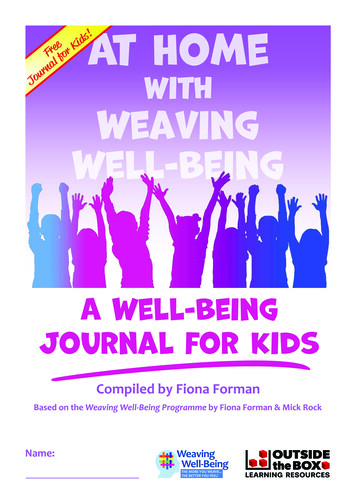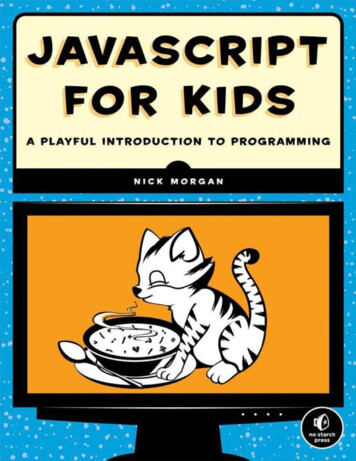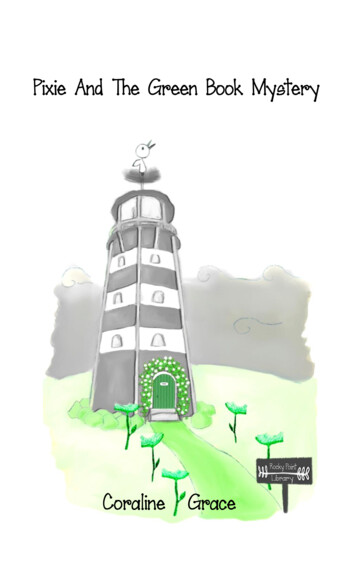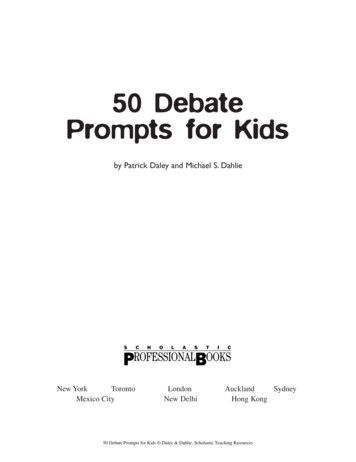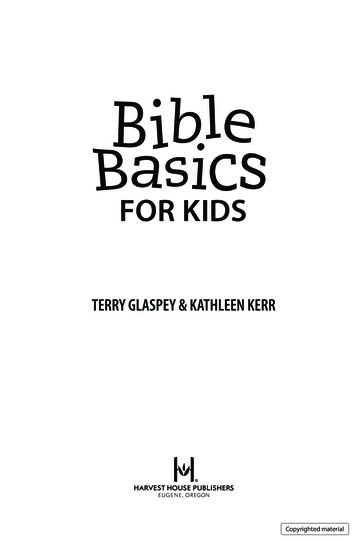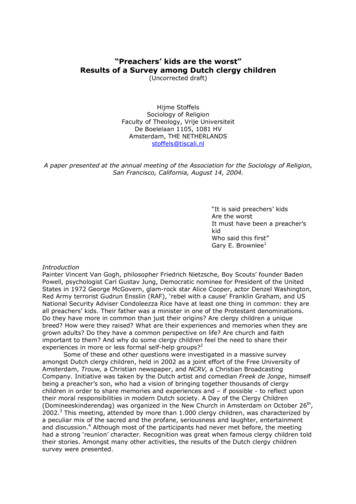
Transcription
“Preachers’ kids are the worst”Results of a Survey among Dutch clergy children(Uncorrected draft)Hijme StoffelsSociology of ReligionFaculty of Theology, Vrije UniversiteitDe Boelelaan 1105, 1081 HVAmsterdam, THE NETHERLANDSstoffels@tiscali.nlA paper presented at the annual meeting of the Association for the Sociology of Religion,San Francisco, California, August 14, 2004.“It is said preachers’ kidsAre the worstIt must have been a preacher’skidWho said this first”Gary E. Brownlee1IntroductionPainter Vincent Van Gogh, philosopher Friedrich Nietzsche, Boy Scouts’ founder BadenPowell, psychologist Carl Gustav Jung, Democratic nominee for President of the UnitedStates in 1972 George McGovern, glam-rock star Alice Cooper, actor Denzel Washington,Red Army terrorist Gudrun Ensslin (RAF), ‘rebel with a cause’ Franklin Graham, and USNational Security Adviser Condoleezza Rice have at least one thing in common: they areall preachers’ kids. Their father was a minister in one of the Protestant denominations.Do they have more in common than just their origins? Are clergy children a uniquebreed? How were they raised? What are their experiences and memories when they aregrown adults? Do they have a common perspective on life? Are church and faithimportant to them? And why do some clergy children feel the need to share theirexperiences in more or less formal self-help groups?2Some of these and other questions were investigated in a massive surveyamongst Dutch clergy children, held in 2002 as a joint effort of the Free University ofAmsterdam, Trouw, a Christian newspaper, and NCRV, a Christian BroadcastingCompany. Initiative was taken by the Dutch artist and comedian Freek de Jonge, himselfbeing a preacher’s son, who had a vision of bringing together thousands of clergychildren in order to share memories and experiences and – if possible - to reflect upontheir moral responsibilities in modern Dutch society. A Day of the Clergy Children(Domineeskinderendag) was organized in the New Church in Amsterdam on October 26th,2002.3 This meeting, attended by more than 1.000 clergy children, was characterized bya peculiar mix of the sacred and the profane, seriousness and laughter, entertainmentand discussion.4 Although most of the participants had never met before, the meetinghad a strong ‘reunion’ character. Recognition was great when famous clergy children toldtheir stories. Amongst many other activities, the results of the Dutch clergy childrensurvey were presented.
During the past decades, several (auto-)biographical and therapeutical books onclergy children were published in Germany (Riess, 1979; Greiffenhagen, 1982 and 1984);the Netherlands; (Dresselhuys & De Leeuw, 1985), and the United States (Lee, 1992;Franklin, 1995; Sanford, 1998). Clergy children have been the subject of severalscientific research projects in various countries (Moy & Malony, 1987; McGown &Sharma, 1992; Anderson, 1998; Campbell, 1998; Hardy, 2001; Strange & Sheppard,2001), but as far as we know, never as extensive as in the Dutch research project of2002. The mass media attention for the Clergy Children Project was also quite unusual,including reports in German, Belgian, and Austrian media.A little bit of historyThe Protestant Reformation abolished celibacy and allowed for the married minister. Aunique social entity developed, already lasting for more than four centuries: the clergyfamily, living in the parsonage. The minister was a man of God and his family had to be amodel of piety and virtue. The minister’s wife had a special task in the congregation andtheir children acted as a role-model for other children. A minister unable to manage hisown family was to be pitied and was not worth of bearing the name of ‘pastor’. In thiscontext sometimes 1 Timothy 3:5 was cited: “If anyone does not know how to managehis own family, how can he take care of God’s church?” Fear of being disgraced publiclyby the supposed bad behavior of the children could lead to rigorous norms in theparsonage, or - when the clergy family itself cherished more liberal norms – to acombination of outward accommodation and inner detachment, showing strikingdifferences between ‘front-stage’ and ‘back-stage’ behavior (Goffman). In many villagesthe parsonage was built right next to the church and every villager could freely observewho went in an out and what was happening inside. All kind of persons seeking for helpvisited the parsonage. Often, the inhabitants experienced the parsonage as a “glasshouse”.5 The clergy children played an important role. Imagine the congregation memberwho is going to the parsonage to announce the death of her husband, and the clergychild who has to take care of this woman, because the father is paying his pastoral visits.The idea of being observed all of the time must have frustrated generations ofclergy children. One of the respondents in our survey adequately described this conditionas one of ‘public property’. Rebellion against the imposed role-model and the struggle fora personal identity have led many clergy children astray/far from home, bothgeographically and mentally. “Preachers’ kids are the worst” it is said in America. Asimilarly negative Dutch expression runs as follows: “Clergy children are devil’s children.”Rebellious behavior in the teenage years often was a cry for attention. The father wasboth present and absent. More than other working fathers the minister had theopportunity to work at home, but the door to his study often was impenetrable for hischildren. The more he was available for his congregation, the less he was there for hisown offspring.At the same time, the parsonage was an important institution of culturaltransmission. Members of the family made music, read books, and had discussions on allkinds of interesting topics. In past centuries, the mayor, the notary, and the Protestantminister built the local intellectual and social elite in many Dutch villages. At a very earlystage, clergy children learned how to deal with different persons and different situations.Secretly, many clergy children were proud of their father’s profession and status. Thefamily was well-respected and the children enjoyed a certain reflected glory. Many sonschose for a clergy career themselves. Some Dutch families existed of six or sevengenerations of clergymen. Many other clergy children found a career in arts, science, andpolitics.Until now, this paper is written in the past tense. In the Netherlands, the traditionalideal-typical clergy family seems to be fading away. The parsonage no longer is a houseright next to the church, where the local church members meet. The pastor’s wife has herown job and is no longer willing to act as an extension piece of the ministry. A growingnumber of female pastors have entered the churches.6 Sometimes, husband and wifeshare a part-time appointment as pastors. In some of the more liberal Dutch Protestant2
congregations gay pastors are allowed. No longer the pastor’s spouse always shares thesame faith. Increasingly, the pastor defines his profession as a ‘normal’ job, abandoningthe idea of religious calling and total availability. Retrenchments in the congregation forceministers to look for a combination of different jobs. The status ladder of Dutch societyshows a slow but steady decrease of the minister’s status since 1945. Massive churchabandonment has taken place during the 20th century, especially from the 1960’sonward. At the beginning of the 20th century, a majority of the Dutch belonged to one ofthe Protestant denominations (60%). At the beginning of the 21st century, thispercentage was reduced to 22% (SCP, 2000).If it is true to describe the traditional clergy family as a vanishing culturalphenomenon, research among those who grew up in these families could provide us withvaluable information about what was going on in the parsonage. At least, this was one ofthe most important reasons to start a survey among Dutch clergy children of all ages.These were the specific research questions: How do clergy children evaluate their youth and upbringing? What are the effects – both positive and negative – of growing up in theparsonage? How have clergy children developed? What stands do they take in matters of religion, morals, politics? Which norms and values do they hold important? Are there significant differences between generations of clergy children?Data and MethodsA lengthy questionnaire, containing both closed and open questions, was developed andtested. In order to trace the addresses of Dutch clergy children, advertisements wereplaced in five national newspapers and two weekly magazines in the Spring of 2002. Themessage invited clergy children of age 16 and older to cooperate in the survey. Thosewho reacted received a written or electronic version of the questionnaire. At the end ofthe questionnaire, respondents were invited to mention the names and addresses ofbrothers and sisters and other clergy children they knew. Responses to this request wereoverwhelming. We expected 300 or 400 respondents, but no less than 2.300 personsreacted. Obviously, the project had a strong appeal on those who spent their youth in theparsonage. After two months the decision was taken to stop sending out questionnaires.In the end, 2.086 valid questionnaires could be processed. Reactions not only came fromthe Netherlands, but also from other countries where Dutch clergy children had moved:Belgium, Germany, the United Kingdom, Norway, the United States, Brazil, South Africa,Australia, and New Zealand.The total number of Dutch clergy children is difficult to assess. The number ofministers of Protestant denominations in the Netherlands during the past century is anestimated 12.500. Suppose that the average number of children in clergy families is four(unmarried ministers and childless couples included), the total number of clergy childrenborn between 1900 and 2000 would be 50.000. Many of those who were born before1920 will have passed away and those born after 1985 were too young to participate inthe survey, which leaves the total population of Dutch adult clergy offspring an estimated32.500. Perhaps it is safer to say that the actual number of adult clergy children probablylies somewhere between 25.000 and 40.000.We have divided the respondents in five generations, following a distinction madeby the Dutch sociologist Becker (Becker, 1992). The ‘Pre-War Generation’ was bornbefore 1930 and grew up in a time of economic crisis and World War II. This generationis visible but relatively weak in our survey.7 The ‘Quiet Generation’ was born between1930 and 1940. They witnessed World War II and the post-war Reconstruction era intheir youth. The ‘Protest Generation’ was born between 1941 and 1955. Members of thisgeneration grew up in the Reconstruction era and the ‘roaring’ 1960’s. The ‘LostGeneration’ was born between 1961 and 1975 and witnessed the 1960’s as well as theperiod of economic recession in the 1970’s and 1980’s. Youth unemployment was highduring these years. The ‘Pragmatic Generation’ is the last one of interest to our survey.Members of this generation were born between 1971 and 1985. They witnessed the ‘no-3
nonsense’ years of the 1980’s and the end of the Cold War during their formative period(see Table 1). If it is true that the traditional Dutch clergy family is vanishing, this shouldbe visible in differences between these generations.Table 1. Generations of Dutch clergy children in the 2002 survey (N 2.083)Born before 1930 (Pre-War Generation)Born between 1930 and 1940 (Quiet Generation)Born between 1941 and 1955 (Protest Generation)Born between 1956 and 1970 (Lost Generation)Born between 1971 and 1985 (Pragmatic Generation)4.6%13.6%30.2%28.3%23.3%ChildhoodA vast majority of the respondents (88.6%) grew up in the Nederlandse Hervormde Kerk(Dutch Reformed Church), the Gereformeerde Kerken in Nederland (Reformed Churchesin the Netherlands), and the Evangelisch-Lutherse Kerk (Evangelical Lutheran Church),three churches which have merged into the Protestantse Kerk in Nederland (ProtestantChurch in the Netherlands) in 2004. Others came from a variety of Liberal, OrthodoxCalvinist, and Baptist churches. In most of the cases the father was the minister. In only1% of the cases the respondent’s mother was the minister and in 2% of the cases bothparents were minister. Most clergy children moved to other places one or more timesduring their youth. The average number of moves is 3.3, but some have moved six ormore times. Only 11.9% spent their youth in one place. The average number of childrenin clergy families drops from 5.3 children in the two older generations (born before 1941)to 4.2 (still relatively high) in the three younger generations. No more than 1.6% of therespondents was only child.Respondents were asked to characterize their parental family on a five-point scaleof thirteen pairs of contrasts, such as warm-cold, open-closed etc. In Table 2 the resultsare summarized . A majority of the respondents characterize their parental family aswarm, open, close, genuinely pious, and outward directed, but at the same time manyrespondents experienced a heavy interference of work and private life, they always hadthe feeling that they were observed, the parent-minister was the center of interest,money-troubles often prevailed (especially among the older generations), and there werestrict rules in the house.Table 2. Evaluations of the family in which respondents were raisedWarm (as opposed to cold)Genuinely pious (vs. faith was just a façade)Heavy interference of work and private life (vs. strict separation ofwork and private life)Always people about the place (vs. never)Open (vs. closed)Always the feeling that the outside world was watching us (vs.never)Outward directed (vs. inward directed)We could talk about everything (vs. no possibility to talk at all)Close, strongly involved in each other (vs. Everybody went his/herown way)The parent-minister was the center of interest (vs. equal attentionfor all family members)Liberal (vs. orthodox)No money-troubles (vs. always money-troubles)Strict rules (vs. freedom)4% 51.8%42.6%40.4%40.0%37.6%31.8%
It is evident that church and faith occupied a special place in the clergy family. Mostfamilies had daily table prayers (92%) and daily Bible reading (71%). Church was veryimportant in 92% of the families, more than faith (81%). At the same time this impliesthat in some clergy families church and faith did not have an important place. A majorityof the clergy children attended church weekly when they were fifteen years old (70%). Atthis age, however, belief in God was not always without doubts (see Table 3).Table 3. Belief in God at the age of fifteen.I believed in GodI believed in God, but I had my doubtsI was seeking; sometimes I believed, sometimes I didn’tI did not know if there was a GodI did not believe in God41%28%16%7%8%Public propertyMost respondents confirmed that it gave them a special feeling to be a clergy child whenthey were young (84%). They could elaborate on these feelings in an open question.Positive and negative answers which were given:- I felt observed, glass house.- Proud, clergy family was the royal family of the village.- I felt like an outsider, at school I was a ‘plaster saint’- Funny: the prince royal; embarrassing: the spotlights.- It took many years to free myself from the sermons of my youth, to discover who Ireally was and in which god I wanted to believe.- Role model.- Alone in the church. Funny to see your father in front of the church.- Actor. Always had to be an example. Attitude: pretending; avoiding public conflicts.- People looked up at me.- Clergy children were not allowed to do mischief; if you did, people said: We did notexpect this from a minister’s daughter.- Loneliness amidst friends; I was treated differently.As youngsters, clergy children had an exceptional position and they were aware of it. Theattention paid to them was ambivalent: both positive and negative. They felt flattered byall attention, the glory of the well-known father was reflected upon them, but attentioncould also be oppressive, feeling observed and judged against a very high moralstandard, different from their peers. They were public property whether they liked it ornot. The mobility of the minister (after four years a minister could receive a call fromanother congregation) meant that the family had to settle down in a new environmentevery now and then.To assess if these feelings were stronger in older generations than in the younger ones,we look at the scores on three items:- As a clergy child you live in a ‘glass house’- They kept an eye on you as a clergy child more than on other children- As a clergy child you had to set an example for other childrenTable 4. Agreement with items per generation‘Glass house’Kept an eyeBorn before 193070.0%78.5%1930 - 194072.4%81.2%1941 - 195573.6%84.3%1956 - 197060.2%73.9%1971 - 198541.5%62.4%5Set an example58.0%63.1%65.3%49.9%33.7%
It is clear that the older generations, including the ‘Protest Generation’ felt thesepressures stronger than the generations born after 1955. The data, however, show nosteady decline per generation, but rather suggest a split taking place in the 1960’s and1970’s, when the typical Dutch phenomenon of ‘pillarization’ (organization of social life onconfessional basis) was crumbling down. Nevertheless, also the younger generations arenot unfamiliar with the feelings of living in a ‘glass house’, being watched, and having toset an example.If we look at possible differences between those who were raised in a ruralenvironment and those who were raised in an urban environment, it appears that the‘rurals’ have the described feelings somewhat stronger than the ‘urbans’. Genderdifferences are almost negligible, but female clergy children felt even stronger than maleclergy children that people kept an eye on them. The data of this survey seem to portraytwo (ideal-typical) types: the orthodox, strict, rural clergy family of the first decades ofthe 20th century and the more liberal, urban clergy family of the last decades.For some clergy children it was too embarrassing to have a look into ‘God’s littlekitchen’. A minority (23%) had rather seen that their father (or mother) would have hadanother job and 11% has lost all respect for the ministry as a clergy child. A 62 year oldwoman wrote: “ at the one hand the famous man, at the other hand the manicdepressive man which I had to call my father.” About three quarter of the respondents(76.0%) tend to evaluate their youth and upbringing in a clergy family as (very) positive,whereas a quarter (24%) has a (very) negative evaluation. Although a minority, thispercentage is rather impressive. The more orthodox the respondents characterize theirparental family, the more negative they evaluate their upbringing. Of those raised in veryorthodox families 37% has a negative judgment, whereas only 17% of those raised invery liberal families have a negative judgment. The more negative their evaluation, thesmaller the chance that they presently have an affiliation with church and Christianbelief. 71% of the very positive evaluators is a church member and 78% believes in God;but only 36% of the very negative evaluators is a church member and 35% believes inGod.One out of every three clergy children has ever thought of studying theology(males 40%; females 26%). The group that actually has studied theology for some timeis 12% and eventually only 3% of the respondents have become a minister themselves.Social, religious, moral, and cultural capitalTo what extent was the 20th century Dutch clergy family a breeding-place of social,religious, moral, and cultural capital? Potentially, clergy children grew up in a stimulatingand interesting setting, where they could meet people of different backgrounds, wherechurch, theology, and morals were present, and where t
being a preacher’s son, who had a vision of bringing together thousands of clergy children in order to share memories and experiences and – if possible - to reflect upon their moral responsibilities in modern Dutch society. A Day of the Clergy Children (Domineeskinderendag) was



